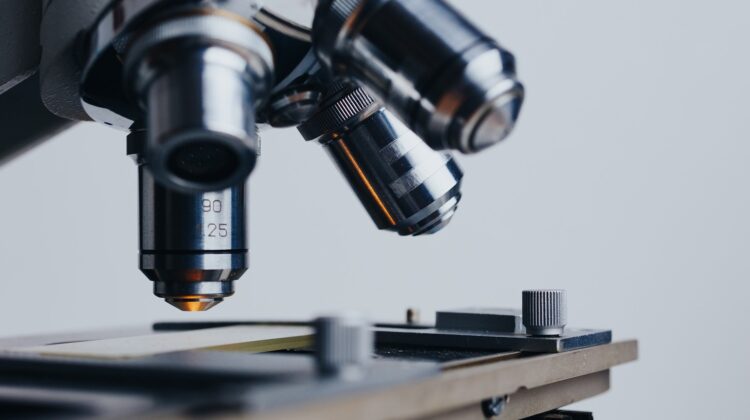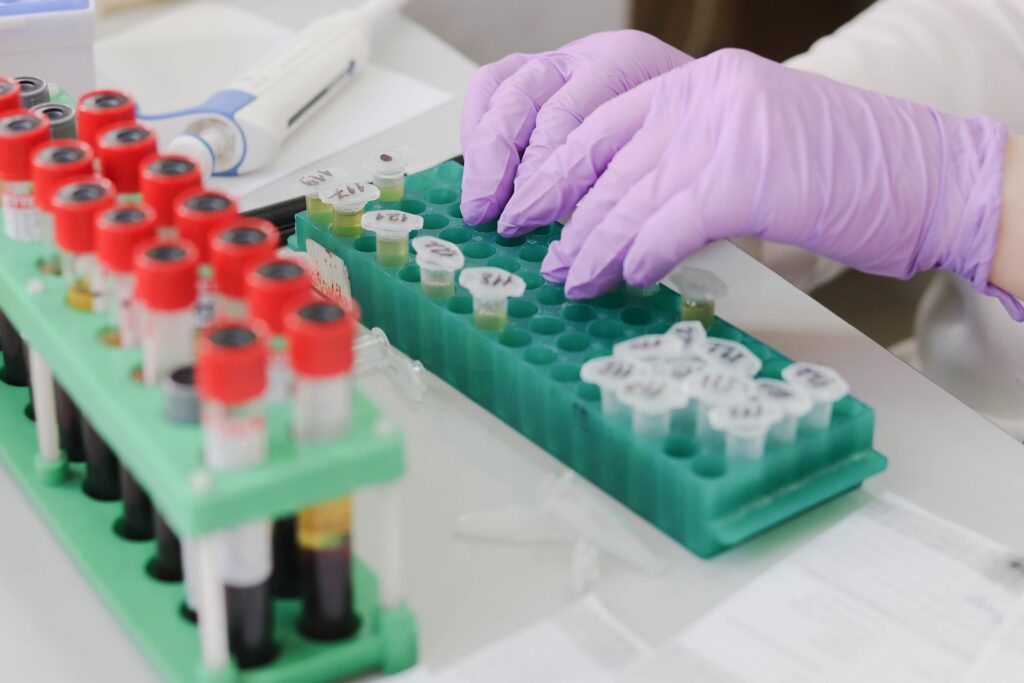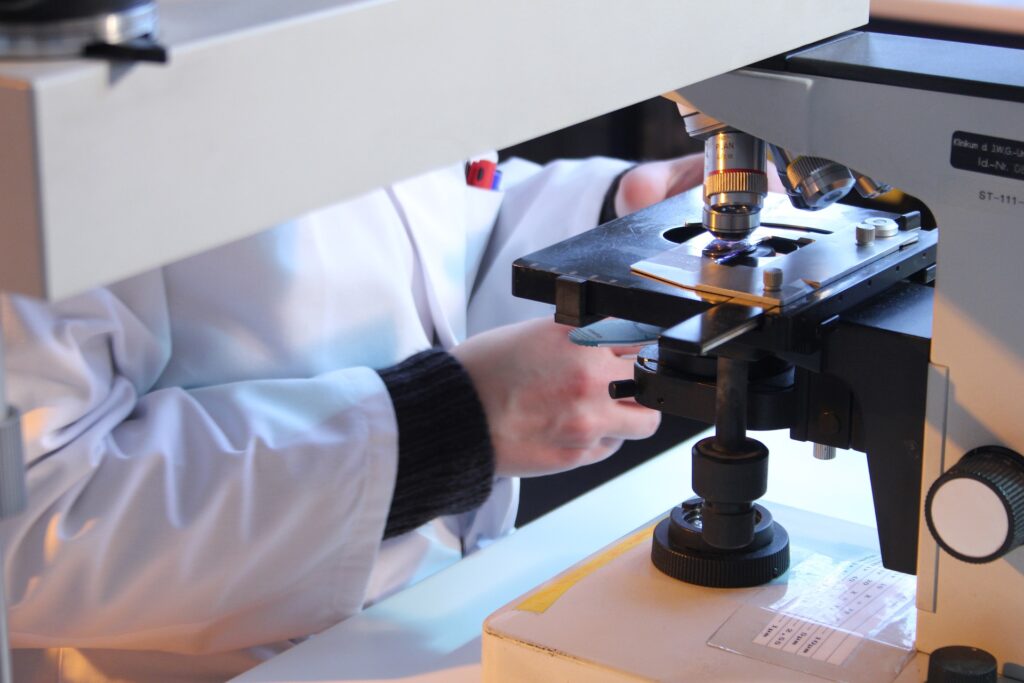
Laboratories as open-plan offices
Since March 2020, the coronavirus disease was formally characterized as a pandemic. Since that time, the COVID-19 pandemic has led to high demand for healthcare resources. Laboratory activities surged due to the rapid increase in testing.
In hospitals or clinics, laboratories operate mainly in the domain of patient-related research and analyses. In private structures, there are more specialized laboratories where various biology analyses can be carried out for different purposes, either medical or non-medical.
One thing all these laboratories have in common is hygienic requirements. It is essential to not contaminate samples that will be analyzed to guarantee correct results. One mistake may have huge consequences. Laboratories are a key resource in the medical process. Depending on the level of hygiene risk, the design requirements may vary.

Acoustics in laboratories
Less obvious but of equal importance is the acoustic environment within laboratories. Medical personnel working in these spaces are usually exposed to high noise levels by design.
Why is that? Mainly for two reasons: 1,) Laboratories are designed with hard and reflective surfaces for hygienic purposes, and 2) Medical equipment/robots used for sample analyses are emitting high noise levels which are emphasized by 1). This makes for a very uncomfortable work environment, especially considering that laboratory work requires high levels of concentration.

Acoustic standards
Only a few standards and regulations touch upon the acoustic aspects of such spaces, rather than focusing on hygiene requirements (exposure to biological agents, cleaning procedures, etc.). The international standards considering laboratory environments are listed below:
The German acoustic standard DIN 18041 [1] comprises two sub-categories that concern laboratories, namely Raumgruppe B3 and B4 (the difference being whether they contain a “permanent workplace”). Here, communication over short distances and the reduction of the noise level are considered essential, thus, a certain quantity of absorbent material regarding the volume of the space is recommended to be introduced (provided as the A/V ratio). Next to that, the Technische Regel für Arbeitsstätten (ASR A3.7) [2], requires task-dependent maximal noise rating levels. For laboratories, a rating level of 70 dB(A) must not be exceeded. In addition, the mean sound absorption coefficient of all surfaces (between 250Hz-2kHz) shall be ᾱ ≥ 0.3 including furnishing.
In Sweden, the local standard SS 25268 [3] advises not to exceed a reverberation time of 0,6 seconds. In France, the reference is the labor legislation: maximum daily exposure is 87 dB(A), and maximum sound pressure level peak is 140 dB(C). These last parameters are rarely reached but it does not mean the working environment is appropriate.
In Denmark, ‘Arbejdstilsynet’ – The Work Environment in Denmark, sets different demands for different spaces based on room volume and ceiling height [4].
| Room | Demand |
| ≤200 m3 | T ≤ 0.8 sec. – 125-2.000 Hz. |
| 1000 m3 | T ≤ 1.3 sec. – 125-2.000 Hz. |
| ≥1000 m3 | A ≥ 0.6 × floor area – 125-2.000 Hz. |
| ≥1000 m3 (ceiling height ≥5 m.) | A ≥ 0.7 × floor area – 125-2.000 Hz. |
Many of these parameters are far from being adapted for a laboratory work environment where a high level of concentration is required.
Open-plan offices
A laboratory environment can also be considered as a workplace similar to an open-plan office with hygiene requirements. For open-plan offices, the new international standard ISO 22955:2021 [5] has recently been published. It defines acoustic targets depending on the activity within a space – the acoustic requirement for a call center is different than for a meeting room or for an office with low collaboration.
It would be interesting to adapt the newly introduced acoustic parameters of the ISO 22955 standard to design laboratories with a human-centered approach where staff well-being is the highest priority. This would allow for separate working areas with different levels of activity, such as areas with focus work and equipment with high noise levels.

Cognitive performance
We know that working in an environment where sound pressure levels are at around 60 dB(A) harms cognitive performance [7]. Imagine working in such an environment with hard, reflective surfaces, varying amounts of equipment, and conversations. Average noise levels may increase up to 80 dB(A). According to the French standard NF S31-080 [8] and the German ASR A3.7 [2], an acceptable noise level at work shall be below 55 dB(A), especially when a high level of concentration is needed. We are far from that in most cases in reality.
On top of that, a good work environment can have benefits: reduce fatigue, reduce the potential of mistakes, increase efficiency, etc. Work carried out in laboratories is of high importance, so improvements to the work environment have a significant impact.
Acoustic descriptor
Considering the high level of concentration required, the way laboratory benches are positioned and how people work in these spaces, the following acoustic descriptors should be investigated further:
- Sound pressure level – LAeq + Lpeak
- Reverberation time
- Sound spatial decay – to see how the sound propagates within the space, especially taking into account noisy machines
- A parameter linked to intelligibility – which could be C50 or STI
The two first ones (except Lpeak) are usually measured and analyzed but it has been shown that these two parameters are not sufficient to characterize a laboratory space correctly. The amount of absorbent material can also be a parameter to investigate but it could be limited as the sound environment of a laboratory is complex due to the equipment that is usually emitting high noise levels. If this indicator is used, the target should be high.
What about defining special targets for laboratories using acoustic descriptors relevant to open spaces? This would enable us to anticipate a sound environment when designing a new laboratory and ensure a comfortable workplace for employees.
This article is written by Anne Pollet who is an engineer in industrial risks and Achim Klein who holds a Ph.D. in psychoacoustics. Both are working as Concept Developers for Saint-Gobain Ecophon.
___________________________
Sources
[1] DIN 18041:2016-03 “Hörsamkeit in Räumen”
[2] ASR A3.7:2021-03 “Lärm“
[3] SS 25268:2007+T1:2017 “Acoustics – Sound classification of spaces in buildings – Institutional premises, rooms for education, preschools, and leisure-time centers, rooms for office work and hotels”
[4] A.1.16 December 2008 ”Akustik i arbejdsrum”, kontorer, mv.
[5] ISO 22955:2021 “Acoustics — Acoustic quality of open office spaces”
[6] NF S31-199 “Acoustics – Acoustics performances of open-plan offices”
[7] Weinstein, N. D. (1977). Noise and intellectual performance: A confirmation and extension. Journal of Applied Psychology, 62(1), 104–107. https://doi.org/10.1037/0021-9010.62.1.104
[8] NF S31-080 : Bureaux et espaces associés. Niveaux et critères de performances acoustiques par type d’espace. AFNOR

